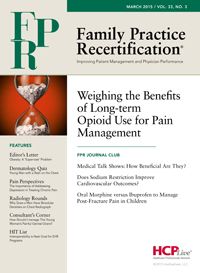Publication
Article
Family Practice Recertification
Oral Morphine Versus Ibuprofen to Manage Post-fracture Pain in Children
Author(s):
Is orally administered morphine superior to ibuprofen for outpatient pain management for children with uncomplicated fractures?
Review
Citation: Poonai N, et al. CMAJ 2014; 186(18): 1358-1363
Study Methods
This study is a randomized, double-blinded superiority trial of 134 children who received care for uncomplicated fractures at a Canadian emergency department over 18 months. Pediatric patients aged 5 to 17 years who sustained extremity fractures within the 24 hour window prior to presentation were chosen to participate. Fractures were confirmed radiographically prior to enrollment.
The mean age of participants was 10 years with female comprising a majority in each group. Transverse fractures were the most common type of fracture with the radius being the most prevalent fracture site. Patients with contraindications to ibuprofen or morphine, chronic analgesic use, additional injuries, hematologic disorders, renal dysfunction, sleep apnea and pregnancy were excluded.
Participants were randomly assigned to receive either ibuprofen (10 mg/kg) or oral morphine (0.5 mg/kg) every 6 hours for a 24 hour period. Acetaminophen (15 mg/kg) could be taken by both groups for breakthrough pain. Pain was assessed using the Faces Pain Scale-Revised; ranging from 0 to 5, with 5 being highest intensity of pain. Patients recorded their pain scores immediately before each dose and 30 minutes after each dose. Adverse effects during the 72 hour period after the first dose were recorded. Patients also reported any doses of acetaminophen taken for breakthrough pain.
The study was powered to detect a difference of 1 face on the Faces Pain Scale-Revised between groups at a power of 80% with a 2 sided level of significance of 0.05. Participants who took at least 1 dose of analgesic were included in the analysis.
Results
Morphine and ibuprofen were shown to have equal efficacy at controlling fracture-related pain as indicated by similar reductions in pain using the Faces Pain Scale-Revised. No statistically significant difference was found between groups when differences in pre- and post-pain scores were analyzed.
Across all four possible doses, the reduction in pain at each time point was similar for both groups. No statistically significant difference between groups was found for the use of acetaminophen for breakthrough pain.
Morphine was associated with a greater number of adverse effects; the most common noted were nausea and drowsiness. Although the proportion of patients reporting drowsiness did not result in a statistically significant difference between groups, approximately 35% of the morphine group was affected as compared with 21% of the ibuprofen group.
Conclusion
Outpatient management of pain related to uncomplicated fractures in children can be managed effectively with either oral morphine or ibuprofen. Since a greater proportion of adverse effects from morphine were observed in this study, ibuprofen is a preferential alternate to morphine in the outpatient setting.
Commentary
The successful management of pain for uncomplicated fractures is crucial to avoiding returns to the emergency department or primary care office for uncontrolled pain. The ideal analgesic is one which alleviates pain with the fewest number of adverse effects. The present study shows oral morphine and ibuprofen are equally effective at controlling post-fracture pain within the first 24 hours after discharge from the emergency department. Ibuprofen was associated with fewer side effects, resulting in its preference over morphine.
Strengths of this study is in its methodology. Both arms of the study were demographically similar with no statistically significant difference was found between patients included in the analysis and those excluded for not requiring any analgesia post-discharge. The protocol allowed for patients and their parents to determine if doses of analgesia and supplemental acetaminophen were necessary, perhaps promoting participation and adherence. As a superiority trial, it allowed for all participants to receive analgesia for pain control and for a direct comparison of two commonly prescribed medications.
The generalizability of this study to other patient populations is arguable given the study participants came from only one children’s hospital in London, Ontario. Inter-regional, social and cultural differences may contribute to the preference for a prescription medication over an over-the-counter medication for treatment of pain or vice versa. Due to the need for completely blinded administration of analgesic, morphine was dosed in 6 hour intervals, identical to ibuprofen. However, oral morphine is typically given every 2 to 4 hours. By extending the time between doses for morphine, the full efficacy of morphine may have been reduced, resulting in the misleading interpretation of non-superiority.
This study provides convincing evidence for clinicians to choose ibuprofen for effective pain management in this pediatric population. Although there is some debate as to whether NSAIDs delay healing of fractures, there is not enough evidence to support withholding NSAIDs for short-term pain control in otherwise healthy children. The participants in this study had uncomplicated, non-operative fractures and their median pain score upon discharge was 2 with an interquartile range of 1-3. A non-narcotic, over-the-counter medication was sufficient to control their pain over the course of 24 hours after their discharge with minimal side effects. More studies are needed to determine ibuprofen’s efficacy in managing pain for more complicated fractures in children with difficult to control pain in the emergency department.
About the Author
Melinda J. Palma is a 4th year medical student at the University of Massachusetts Medical School.






